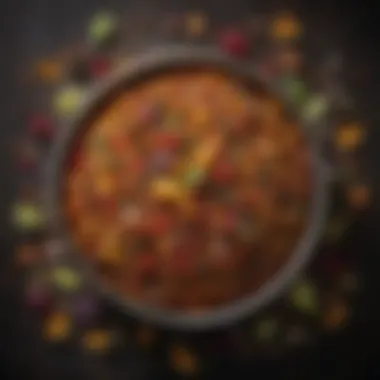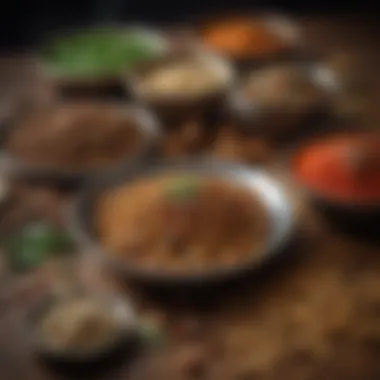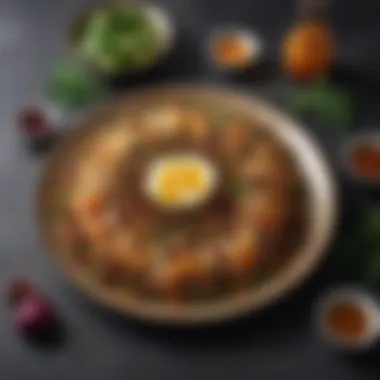Exploring Mukhwas: The Essence of Indian Culinary Culture


Intro
Mukhwas represents more than just a simple post-meal indulgence; it captures a deep cultural tradition interwoven with aromatic ingredients and health benefits. Originating from India, this sweet-scented mixture is enjoyed primarily after meals to assist digestion and freshen the breath. Each bite offers a glimpse into the rich tapestry of Indian hospitality and culinary artistry.
Recipe Overview
- Name: Classic Mukhwas Medley
- Portions: 4 to 6 servings
- Prep Time: 10 minutes
- Cook Time: None
- Difficulty: Easy
- Main Ingredients:
- Fennel seeds
- Sugar
- Coconut (dried or grated)
- Cardamom pods
- Edible food color (optional)
Mukhwas can be a simple mix, or it can include various seeds, nuts, and spices that elevate its flavor and appeal. It's essential to respect individual palates and preferences while crafting this delightful blend.
Step-by-Step Instructions
To create your Classic Mukhwas Medley:
- Prep Ingredients:
- Mixing the Mukhwas:
- Cooling and Serving:
- Lightly toast the fennel seeds in a dry pan until fragrant, about two to three minutes. This step helps release their natural oils.
- Crumble the cardamom pods to release more flavor, discarding the shells.
- If using coconut, ensure it is finely grated or shredded.
- In a bowl, combine the toasted fennel seeds, crumbled cardamom, and grated coconut.
- Add sugar, adjusting the amount to preference.
- If desired, incorporate edible food color, mixing well to distribute evenly.
- Spread the mukhwas mixture on a baking sheet to cool completely.
- Store in an airtight container, ready for serving after meals.
Time-Saving Strategies
- Use store-bought toasted fennel seeds if you're pressed for time.
- Consider using pre-grated coconut available in many markets.
- For variations, incorporating ready-made flavored powders can enhance the taste.
Nutritional Information
This nourishing mix offers various health benefits:
- Calories: About 40 calories per tablespoon
- Proteins: 0.5g
- Fats: 2g
- Carbohydrates: 6g
- Dietary Fiber: Negligible since it's mostly seeds and sugar.
Beneficial nutrients in this dish include fiber from fennel and good fats from coconut, enhancing digestion and overall health benefits.
Quick Cooking Tips
- Try preparing mukhwas in larger batches to save time in the future.
- Use a food processor to finely chop ingredients quickly if preferred.
- Add spices like peppermint leaves or dried rose petals for varied flavor experiences.
Related Recipes & Variations
- Fennel and Sesame Delight: Can substitute sesame seeds for coconut, enhancing the nutty flavor.
- Sweet and Spicy Parle-G Mukhwas: Included crushed cookie bits for texture and sweetness.
- Vegan Choices: Adapt ingredients to include only plant-based options and ensure allergies are addressed well.
Readers are encouraged to experiment with these recipes and share their unique takes on mukhwas, fostering a cross-cultural exchange of delightful flavors in every bite.
Preface to Mukhwas
Mukhwas holds a distinctive place within Indian culinary traditions. It is more than just an after-meal treat; it encapsulates cultural practices, health benefits, and geographic diversity. As one ventures into understanding mukhwas, it is vital to recognize its role not only in the culinary world but also in social contexts.
Defining Mukhwas
Mukhwas can be defined as a fragrant mixture typically enjoyed after meals in India. It is commonly composed of a variety of seeds, nuts, herbs, and spices, often sweetened with sugar or jaggery. Usually served in small bowls, mukhwas caters to a dual purpose: aiding digestion and enhancing breath freshness. The vibrant colors and textures attract attention, making it a notable feature at Indian dining tables.
Historical Context
Historically, mukhwas has its roots steeped deeply in India, where it is linked to traditional medicine practices. Ancient texts suggest that certain ingredients used in mukhwas had therapeutic properties. Seed mixtures and mouth fresheners were not only choice flavors but were also believed to promote health and wellness. As Indian households evolved, the inclusion of mukhwas continued, reflecting India's rich variation in spices and local ingredients. Its relevance expanded over centuries, making mukhwas a staple that represents both culinary artistry and cultural heritage.
"Mukhwas is a significant embodiment of the intersection between food, culture, and tradition. It is enjoyed not only for its flavor but for its underlying health benefits as well."


Understanding mukhwas is essential for both culinary enthusiasts and those interested in the cultural tapestries of Indian society. The various flavors and nutritional advantages stimulate an interest that encourages one to explore beyond routine dining experiences.
Culinary Significance of Mukhwas
Mukhwas holds a special place in Indian culinary tradition, primarily because of its multifaceted role after meals. Not only does it offer a delightful sensory experience, but it also aids in digestion, addresses post-meal sentiments, and adds to the ritual of dining. The significance of mukhwas transcends mere taste, securing it as a staple in many Indian households.
Digestive Properties
Mukhwas is known for its digestive properties, which are significant. Composed of various seeds and herbs, it has mild gastrointestinal benefits. Ingredients like fennel seeds (saunf), coriander seeds, and sesame seeds act as catalysts for digestion. These components promote the secretion of digestive enzymes, effectively alleviating discomfort such as bloating and indigestion.
Moreover, some elements within mukhwas can function as natural coolant for the stomach, helping minimize acidity. The act of chewing mukhwas is someting that allows you to artfully extract the subtle flavors while your body begins to absorb its beneficial properties. This process connects a culinary experience with biological function.
Traditional Uses in Indian Cuisine
The traditional use of mukhwas in Indian cuisine is deeply entrenched in the cultural fabric. Not limited to a post-meal palate cleanser, mukhwas forms an integral part of social gatherings, festivals, and hospitality. It is customary to serve mukhwas after meals as a gesture of goodwill and to enhance the eaters' spirits.
In regional recipes, different variations of mukhwas are made, each expressing the rich diversity of Indian cooking. Some mukhwas blends include coconut, jaggery, or aniseed, capturing the essence of local flavors. Each variation tells the story of its origin, bringing together a confluence of customs, hospitality, and taste. This intricate use highlights the culinary prowess within Indian tradition.
“Mukhwas serves not just as a digestive aid but also as a welcoming note, bridging the gap between flavors and community.”
The elaborate combinations used emphasize the deep connections linking food and culture in Indian society. Thus, the culinary significance of mukhwas reveals its dual purpose, providing both sustenance and strength to social relations through culinary arts.
Common Ingredients in Mukhwas
Understanding the common ingredients in mukhwas is essential, as these components not only define its flavor but also contribute to its health various benefits. The blend of these ingredients is what makes mukhwas not merely a post-meal accompaniment but a significant part of culinary heritage. Here, we explore the primary elements found in mukhwas: seeds and nuts, herbs and spices, as well as sugars and sweeteners, each playing a pivotal role.
Seeds and Nuts
Seeds and nuts form the backbone of mukhwas, providing crunch and diverse flavors. Commonly used seeds include fennel, sesame, and anise. Fennel seeds, with their mild licorice taste, are generally preferred. They aid in digestion, making them an excellent choice after meals. Sesame seeds add a nutty complexity, coming with their bonus of healthy fats. Nuts like almonds or cashews can also be included for a richer texture.
- Fennel Seeds: Enhance digestion, freshen breath, and impart a sweet-like taste.
- Sesame Seeds: Provide healthy fat, contribute to flavor and texture.
- Nuts (Almonds/Cashews): Offer richness, flavor diversity, and can contribute more nutritional value.
Applying a balance of these ingredients can elevate the sensory experience mukhwas provides.
Herbs and Spices
Herbs and spices are indispensable in mukhwas. They introduce aromatic compounds that enrich the eating experience. Common herbs used in mukhwas include coriander and mint. The inclusion of spices, such as cardamom, enhances the overall taste and works as digestives. Each herb or spice has unique benefits, offering both flavor and health improvements.
- Coriander: Provides a citrus-like flavor and is known for its anti-inflammatory properties.
- Mint: Known for its cool flavor and digestive properties. Can also freshen breath effectively.
- Cardamom: Eases digestive discomfort, providing warmth to the blend with its distinct taste.
Selecting the right combination informs the overall health benefits while providing a flavorful kick to the mukhwas blend.
Sugar and Sweeteners
Sugar acts as a base, binding the flavors and attracting taste buds. Mukhas often incorporates sweeteners like jaggery or sugar syrup. Each sweetener brings its effects on the final mixture. For instance, jaggery is unrefined and contains nutrients; therefore, it is seen as healthier compared to processed sugar.
- Sugar: Provides sweetness, creating a more palatable taste profile.
- Jaggery: Rich in nutrients; helps with digestion and adds depth in flavor.
The combination of these sweetness options not only creates a pleasant taste but adds nutritional value, enabling mukhwas to stand out.
Common ingredients in mukhwas create a delightful balance of health benefits and robust flavors, redefining the climatic experience after meals.
Being aware of these common ingredients aids anyone in understanding and appreciating mukhwas further. By combining seeds, nuts, herbs, spices, and suitable sweeteners, one can cultivate rich blending techniques to create both traditional and innovative variations.
Health Benefits of Mukhwas
Mukhwas, an integral part of Indian cuisine, offers a range of health benefits that extend beyond its role as a pleasant post-meal treat. Understanding these benefits enhances the appreciation of this delightful mixture. Its diverse ingredients contribute to various health effects, making it more than just a flavor enhancer.
Aiding Digestion
One prominent aspect of mukhwas is its ability to aid digestion. The key ingredients found in mukhwas, such as fennel seeds and aniseed, are well-known for their digestive properties. They help stimulate digestive enzymes, facilitating better breakdown of food. Many cultures, including Indian, believe in the therapeutic roles of these seeds.


Effectively, mukhwas serves the purpose of a soothing instant digestif. Its distinct flavors encourage the secretion of bile, which is important for fat digestion. Additionally, consuming mukhwas after a meal can mitigate discomfort associated with overeating.''
Some potential benefits of mukhwas for digestion include:
- Reduces bloating sensation.
- Helps relieve gas.
- Soothes stomach irritation.
- Can improve overall digestive efficiency.
Antioxidant Properties
Another significant benefit of mukhwas is its antioxidant properties. Antioxidants play a crucial role in neutralizing free radicals in the body, which can lead to chronic diseases. Ingredients found in mukhwas, like turmeric and cardamom, are loaded with antioxidants. Their potential to fight oxidative stress cannot be ignored.
Incorporating mukhwas can support overall health, potentially lowering the risks associated with inflammation and chronic illness. The antioxidants in mukhwas may also:
- Contribute to skin health by combating oxidative damage.
- Support heart health by maintaining healthy blood pressure levels.
- Enhance the body’s immunity.
Breath Freshening Effects
Mukhwas holds a reputation in India not just for taste but effectively for breath freshening. Ingredients like mint and aromatic herbs not only elevate the flavor but also work wonders for oral hygiene. Traditionally, these elements are meant to combat strong odors often left after consuming rich foods.
Instead of reaching for commercial breath fresheners filled with artificial chemicals, indulging in a handful of mukhwas can provide a natural alternative. Some of its breath-freshening benefits include:
- Kills odor-causing bacteria in the mouth.
- Raises saliva production, aiding in natural cleaning of oral bacteria.
- Leaves a refreshing aftertaste post-meal.
Overall, mukhwas proves its worth as more than a post-meal enhancement but a medicinal blend promoting both health and freshness. Embracing mukhwas allows one to enjoy a balanced approach to gastronomic artistry combined harmoniously with well-being.
Cultural Significance of Mukhwas
Mukhwas holds a unique position in Indian culture and culinary practices. It transcends being merely a post-meal treat, reflecting values, beliefs, and the warmth of Indian hospitality. Understanding its cultural significance illuminates how mukhwas serves as a bridge between food and tradition, connecting generations and communities through a shared love for this aromatic concoction.
Roles in Indian Hospitality
In Indian hospitality, offering mukhwas to guests symbolizes respect and warmth. It is common to see mukhwas presented after meals, completing the dining experience. This custom not only aids in digestion but also acts as a gesture of gratitude toward those gathered at the table. Visitors are often engaged with flavors that reveal the host’s thoughtfulness and care.
Moreover, various types of mukhwas can reflect regional preferences. Some areas might favor a sweet mix of fennel seeds and sugar, while others could lean towards a more herbal composition. Meeting guests with regional delicacies can be a proud moment for hosts, showcasing culinary diversity while honoring the tradition of hospitality.
Key Points:
- Guests receive mukhwas as a token of hospitality.
- Regional variations highlight India's diverse culinary culture.
- It indicates respect and thoughtfulness from the host to the guests.
Mukhwas in Indian Festivals
Festivals in India are grand events filled with color and joy, and mukhwas plays a role even in these celebrations. During special occasions such as Diwali, Holi, or weddings, offering mucmuwas is an immediate tradition. The flavor combinations chosen often correspond to the festivities, enhancing the experience.
For instance, during the festival of Diwali, sweet flavors dominate. Mukhwas might include specialty ingredients like cardamom or jambu seeds, aiming for a festive touch. Meanwhile, during quieter times or personal gatherings, simpler blends may be preferred.
By incorporating mukhwas into celebrations, people strengthen their connection with their cultural identity. Not only does it fuse together different tastes, but it forges bonds over shared experiences, enhancing communal joy. Ultimately, mukhwas is not just about flavor; it embodies cultural heritage.
“Mukhwas is more than a postmeal treat; it is a delightful symbol of Indian tradition that flourishes in festivities and gatherings.”
Important Elements:
- Mukhwas enhances the celebration experience during festivals.
- Flavors may vary according to the season or celebration.
- Shared experiences over mukhwas promote unity and cultural transmission.
Modern Variations of Mukhwas
Modern interpretations of mukhwas reflect its ability to adapt and remain relevant in contemporary culinary practices. These variations coexist with traditional recipes, bringing fresh perspectives and flavors that encourage both nostalgia and innovation among culinary enthusiasts.
Fusion Recipes
Fusion recipes merge the classic elements of mukhwas with international ingredients, creating exciting and unique flavor combinations. For example, one might find mukhwas incorporating ingredients like chocolate or herbs typical to Mediterranean cuisine. These twists add layers of complexity, appealing to a broader audience.


Some popular fusion variations include:
- Mukhwas Granola Bars: Combining traditional mukhwas components such as fennel seeds and sesame with oats, honey, and dried fruits, these bars serve as a healthy snack that retains cultural significance.
- Savory Mukhwas Tart: A tart featuring a pastry crust filled with a mix of roasted nuts, seeds, and aromatic spices reminiscent of mukhwas. This dish makes for a delightful appetizer or hors d'oeuvre at gatherings.
- Dessert-Centric Mukhwas: Utilizing elements such as sweetened coconut and fresh fruits mixed into traditional mukhwas can offer a refreshing dessert option that intrigues the palate.
These recipes not only highlight mukhwas versatility but also allow culinary enthusiasts to experiment with different textures and flavors, contributing to greater appreciation of the ingredient's rich heritage.
Commercially Available Mukhwas
The market has increasingly embraced mukhwas, leading to the emergence of various commercially available products. Such options provide accessibility, enabling individuals to enjoy this traditional post-meal delight without the tedious effort of preparation.
Common brands and products in the marketplace include:
- Pataka Mukhwas: Known for their assorted flavors and high-quality ingredients, they offer a convenient approach to enjoying mukhwas.
- Haldiram's Mukhwas: This brand features traditional spice blends to cater to various tastes, ensuring authenticity in flavor.
- Bikanervala Mukhwas: Offers both classic and modern variations, appealing to diverse customer preferences while maintaining its authentic essence.
These commercial options are becoming prevalent, encouraging broader consumption and appreciation. Consumers can integrate mukhwas into their experiences with ease, making it possible for everyone to partake in this culturally rich tradition.
“Mukhwas serves not just as a digestive agent but as a cultural artifact, embodying centuries of Indian tradition.”
DIY Mukhwas Recipes for Busy Individuals
Creating your own mukhwas at home not only reinforces its presence in your culinary routine but also offers the satisfaction of customization. In this fast-paced world, busy individuals often find it challenging to prepare traditional snacks or after meals refreshers. However, DIY mukhwas recipes cater to the need for convenience without sacrificing quality or flavor. These preparations provide nutritional benefits, serve as a digestive aid, and enhance your overall dining experience. Moreover, making mukhwas at home allows you to tailor it to your specific taste preferences and health requirements, bringing an element of personal touch to this traditional after-meal remedy.
Basic Mukhwas Mix
A classic mukhwas mix is simple to prepare and delightful in taste. This recipe captures the essential ingredients while allowing for variety. Here’s how to create your very own basic mukhwas mix.
Ingredients
- 2 tablespoons of fennel seeds
- 1 tablespoon of sesame seeds
- 2 tablespoons of grated coconut (optional)
- 1 tablespoon of dried rose petals
- 2 tablespoons of sugar (or jaggery for a healthier option)
- 1 pinch of salt
Instructions
- Combine all ingredients in a bowl. If you opt for grated coconut, ensure it’s unsweetened for the best flavor.
- Mix thoroughly, so that each component is uniformly distributed.
- Store in an airtight container. This keeps it fresh and allows you to enjoy it whenever you like.
- Use a teaspoon after meals as a chatpata palate cleanser.
This basic mukhwas can easily be adjusted to include different types of seeds or sweeteners, giving you flexibility in your creation.
Sweet and Spicy Variation
Adding a twist to traditional mukhwas can be a delightful experiment especially for those who enjoy bold flavors. This sweet and spicy variation incorporates unique elements to tantalize your taste buds.
Ingredients
- 2 tablespoons of fennel seeds
- 1 tablespoon of dried ginger powder
- 1 tablespoon of crushed black pepper
- 2 tablespoons of sugar/honey
- 1 tablespoon of tamarind paste (for tartness)
- 1 tablespoon of coconut slices (optional)
Instructions
- In a small pan, lightly roast the fennel seeds for a few minutes. This will help release their flavor.
- Mix all the ingredients in a bowl incorporating the sugar or honey until fully dissolved.
- Add a pinch of salt to enhance the taste.
- Store this mix in an airtight jar for up to two weeks, if it lasts that long.
- This blend can also be enjoyed after meals. It offers the same digestive benefits, with an added zing.
For both versions, mukhwas can serve as more than just a digestive aid. Its essence in Indian culture encourages culinary experimentation, making it relevant and engaging. While you create these spice-infused blends, consider adding your personal touch based on health goals.
Culmination
Recap of Mukhwas' Importance
Mukhwas is more than just an after-meal treat; it is a testament to the culinary richness and complex traditions rooted in Indian culture. This aromatic mixture, consumed widely across the country, carries with it a heritage that has evolved through centuries. Its ingredients are carefully curated, often based on family recipes passed down through generations. This practice symbolizes the emphasis on hospitality in Indian society. By serving mukhwas, hosts show care for their guests’ comfort and well-being, aligning with deeper cultural values awarded to food and dining experiences.
Additionally, mukhwas has practical benefits. Many ingredients support digestion and offer fresh breath, showcasing a blend of deliciousness and health awareness. In modern lifestyles, where convenience is crucial, its role remains timely and relevant.
Encouraging Culinary Exploration
For culinary enthusiasts, the exploration of mukhwas is an invitation to engage not just with the flavors but also with the narratives embedded in each ingredient. Making DIY mukhwas can lead one to experiment with diverse flavor profiles, revealing personal preferences and regional variations.
The creative aspect of customizing mukhwas denotes a broader engagement with one's culinary environment. Exploring this traditional dish can feel like unraveling a calling to embrace India's diverse culinary landscape. This becomes achievable with every aromatic mix crafted in one's kitchen.
Endpoint practices, such as engaging in online communities (like those on reddit or facebook), can enhance such a culinary journey. These platforms provide ample resources, from recipes to suggestions for ingredient substitutions. This kind of active participation fosters knowledge-sharing and appreciation for this integral part of Indian culinary culture.
Mukhwas stands as a reminder of how food can connect us to heritage and how adapting tradition might lead to exciting, contemporary interpretations.







